I like to think that there are two main groups of people who are bolstering the Icelandic Tourist industry: medievalists (like myself) and the “ecotourist” (well, I may be one of those as well). At least a third- and probably more- of the 45 students in the Modern Icelandic Summer School are medievalists here to improve their Old Norse-Icelandic language skills through the study of Modern Icelandic. I haven’t asked the tourists on the street why exactly they chose to come to Iceland, but I have the sinking feeling that it might not have much to do with medieval literature- though their hiking backpacks could very well be filled with books. As much as the History Channel’s Vikings may inspire some travelers, the reality is that Iceland’s incredible (ótrúlegt) landscape (landslag) is really what has sky-rocketed the Icelandic economy after its devastating crash in 2008.
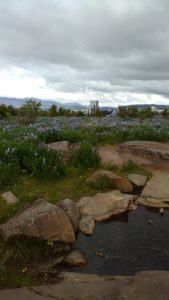
As I mentioned in my last post, the views of nature from Reykjavík itself can be jaw-droppingly exquisite. But in order to get a more complete sense of what the Icelandic landscape is all about, you really have to get out of the city and either rent a car or take one of the organized tours which leave from Reykjavík (some of these are day trips, others for multiple days). As I’m here primarily to improve my Modern Icelandic (no small task!) I will not be able to see all of Iceland while I’m here, but I have made some small trips on the western and southern coasts. You barely have to drive 200 meters in any direction before you want to stop for a photo!
Last week I went on the “South Coast Tour,” which takes travelers to see some outstanding waterfalls (Skógafoss and Seljalandsfoss), as well as one of the famous so-called “black sand” beaches (Reynisfjara). My tour guide, an Icelandic woman named Ragna, explained that that 2010 volcanic eruption of Eyjafjallajökull (say that five times fast) really put Iceland’s otherworldly nature on the map. The positive long-term consequences for the Icelandic economy have far out-weighed the immediate negative consequences of precluding air-traffic across Europe for six days (at least, for the Icelanders). Not only did Icelanders enjoy the many (unsuccessful) attempts of foreign media to pronounce the name of the volcano, but the country launched a tourism advertisement campaign that some Icelanders now deem too successful. The world was suddenly very aware of Iceland’s natural wonders. As one of my instructors succinctly stated: “Iceland is currently ‘In’.”Some Icelanders are concerned that the busloads of tourists increase pollution and could potentially disrupt or even destroy the essence of the natural sites. But Icelanders are also well aware that international interest in their sites could be a passing fad, and some are worried that another financial crisis will come when the tourists find another place to go.
Anyway, here are some of the favorite haunts of “ecotourists” on which I, too, have now left my carbon footprint. Take a look and judge for yourself- do you think people will lose interest in Iceland anytime soon?
The “South Coast Tour”
First Stop: Sólheimajökull (means something like “sun of the worlds glacier”). You really get a sense of how big it is when you make out the tiny people along the side of the glacier! This glacier is receding at an alarming rate due to climate change. 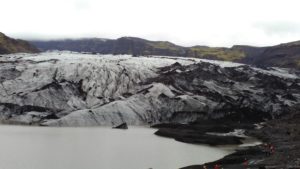
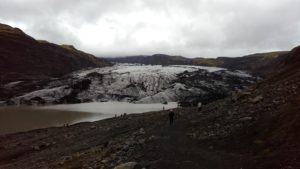
Skógafoss (“Waterfall of forests”): It’s hard to get an idea of just how enormous this waterfall is based on the pics, but try to see the tiny people climbing up the side of the waterfall along the path in the picture below. And yes- lots of people camp and even hitchhike as they explore Iceland’s natural wonders!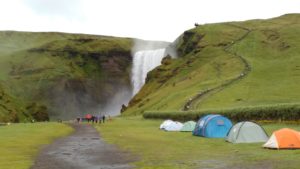
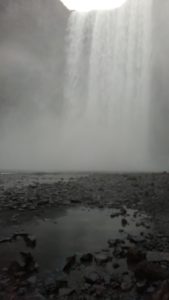
Reynisfjara (“Beach of the Mountain Ash”): An exquisite black beach It was very rainy and windy the day I was there, and the waves are known to be dangerous.
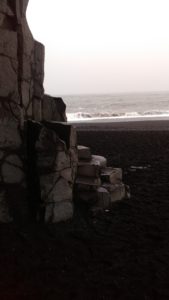
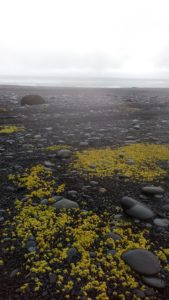
Reynisdrangar (“Pillars of the Mountain Ash”): These basalt sea stacks are strikingly beautiful and otherworldly. Our tour guide told us that they might be trolls, caught by the rays of the rising sun and turned to stone :). It’s hard to tell from the picture, but they are enormous.
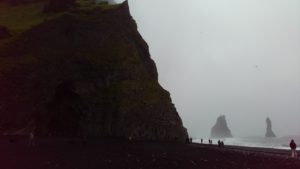
Seljalandsfoss (“Waterfall of Seljaland”): You can actually walk behind this waterfall, but I couldn’t get a decent picture from behind it because the wind was blowing water in my face the whole time. It was an awesome experience, though! 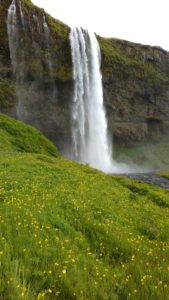
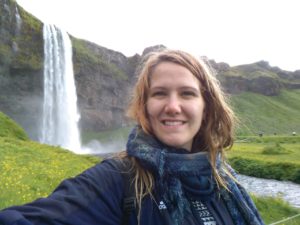
Well, that’s plenty for now, but stay tuned for more about Iceland’s incredible nature and culture coming up soon!